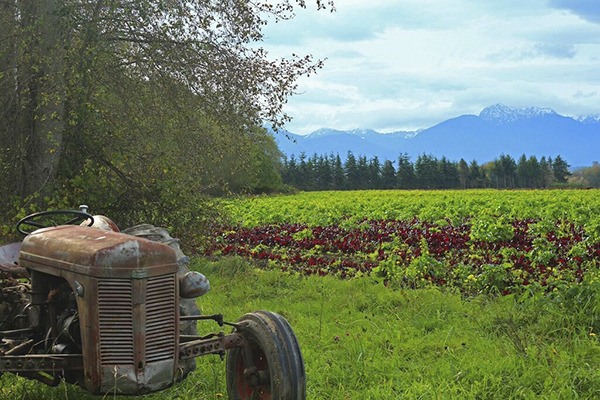An effort to conserve a notable 60-acre farm is under way.
In the shadows of the Olympic Mountains the “Historic” Ward Farm has fulfilled a variety of agricultural purposes for 157 years, Tom Sanford, North Olympic Land Trust executive director, said. The farm remains one of few large plots of farmland to border the banks of the Dungeness River.
Although much of the farmland in the Sequim-Dungeness Valley is vulnerable to many uses, the Land Trust and property owners of one the valley’s oldest farms are collaborating to ensure the “Historic” Ward Farm always will remain available for agriculture.
“This is a historic farm that deserves to be recognized,” Tim Wheeler, farm co-owner, said. “It’s a magnificent piece of land that should be farmland forever.”
Through the ages
Wheeler’s father, Don, purchased the farm in 1957 to expand the family dairy and increase grain production. The Wheelers became the farm’s second and last owner. At the peak of the Wheelers’ dairy operation, they were producing about 300 gallons of milk per day, Wheeler said. Prior to the Wheelers buying the farm, it was developed and farmed by William Ward.
At 12 years old, Ward left England as a cabin boy on a ship, according to “Sequim: Pioneer Family Histories from 1850-World War II.” By the time the ship had reached Port Townsend, Ward jumped ship in 1855. He made his way to the Sequim-Dungeness Valley where he homesteaded and began farming what would become the Ward Farm at the corner of Woodcock and Ward roads in 1858.
The farm is smaller than its original size of more than 100 acres, but the heart of Ward Farm has remained in agriculture since the mid-1800s.
“We are committed to preserving farmland to maintain the cultural heritage of the Sequim-Dungeness Valley and as such we are excited to announce our latest effort to secure the funds needed to conserve the Historic Ward Farm north of Sequim,” Sanford said.
Having incorporated Friends of the Fields, within its 25 years the Land Trust has conserved 3,200 acres countywide. The thousands of successfully conserved acres support the organization’s long-term goal of conserving lands that sustain the ecological and economic vitality of the communities of Clallam County.
Of those acres, about 460 are working farmland.
To kickstart the Land Trust official’s work on the Ward Farm, the organization was awarded $344,000 during the last state legislative session toward the permanent conservation of the “historic” farm, Sanford said.
“While we have a number of farmland projects in the pipeline, this pledge was just the investment needed to focus our efforts and get the ball rolling,” he said. “Building on the momentum provided by the state, in the coming year we will reach out to additional donors and secure available grants to ultimately conserve this property and keep local farmland available.”
The Nash’s connection
For nearly 11 years the Wheeler family has leased the Ward Farm to Nash Huber, owner of Nash’s Organic Produce. The 60-acre field is one many local fields that together equate to more than 400 acres managed under Nash’s Organic Produce and kept in agriculture.
Because the Ward Farm provides one of two fields that has a well on it, Nash’s officials relied heavily on it throughout the summer given the drought and the looming possibility of no water for irrigation.
“We used it (the field) extensively this year,” Patty McManus-Huber, co-owner of Nash’s Organic Produce said. “The field was used as a turf farm for years and has some issues but not insurmountable obviously because it supplied most of our vegetables this year.”
Using cover crops and composting techniques, Nash’s officials have been able to steadily regain the rich fertility of the farm’s soil once hindered by sod and turf production.
During the winter, the Ward Farm supports many of the winter crops grown by Nash’s, such as carrots, kale, Brussels sprouts, cabbage and leeks. Additionally, Huber utilizes the field to grow about a dozen varieties of kale seed, including a couple varieties he has bred throughout the past 15 years.
“This is where the rubber hits the road,” Huber said while walking through the Ward Farm. “This is where you get to see the varying colors, level of disease resistance … just all the differences.”
Within the past 10 years the Ward Farm has been integrated into Huber’s production cycle, he said, but as the climate continues to shift, its importance has grown.
“We have several properties in the (Dungeness River) delta but this is one of the more important ones because it has a water right and that water is essential,” he said.
The “unique climatic zone, rainfall, irrigation system and sunshine” found within the Sequim-Dungeness Valley are all “key” in allowing for year-round vegetable production Huber said.
“You have to go about 2,000 miles south of here before you can get winter crops like we can get here,” he said. “It’s important we keep this farmland around.”
Huber is inspired to see some young farmers continuing to pursue agriculture locally, as well as the efforts like those by North Olympic Land Trust.
“Tom’s (Sanford) leadership at the Land Trust is so key,” he said. “It’s been a long time coming to try to save this place (Ward Farm).”
Reach Alana Linderoth at alinderoth@sequimgazette.com.


